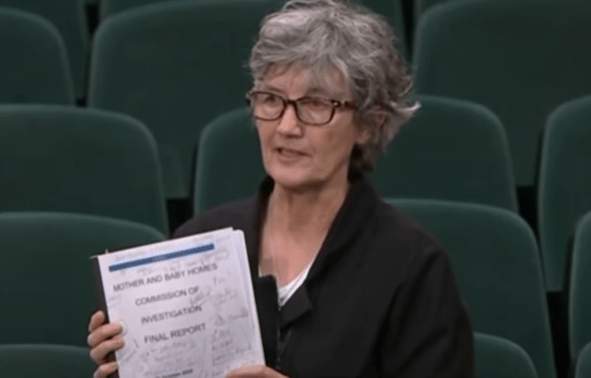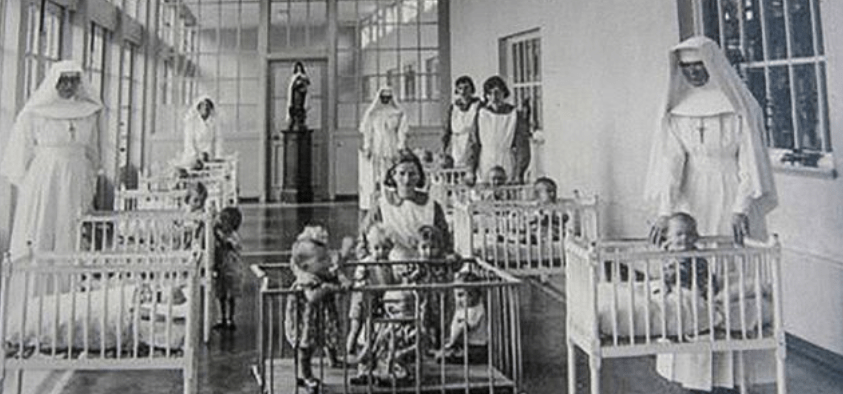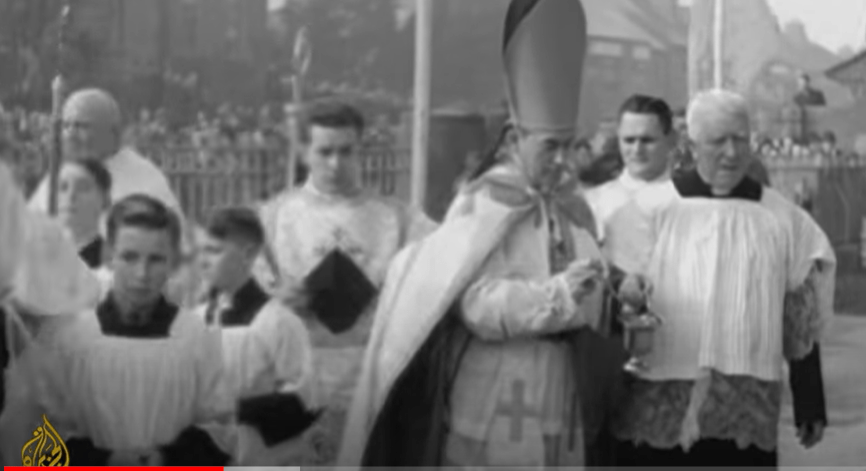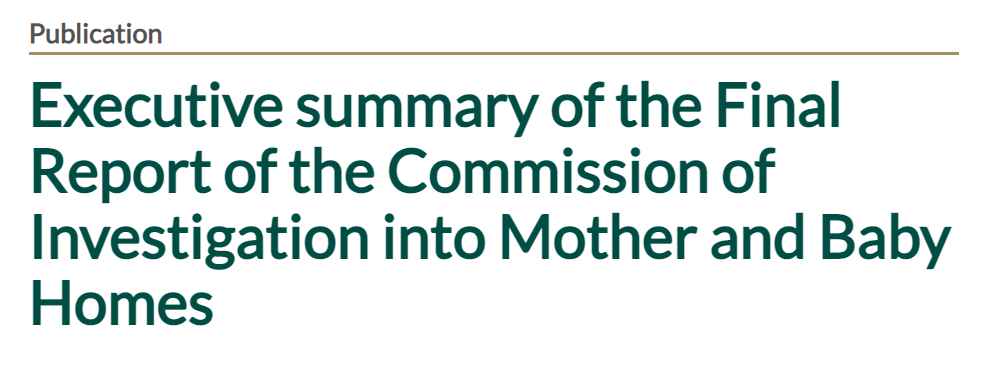The trauma of the Mother and Baby homes
By Saoirse Nic Gabhainn and Lorraine Grimes, Galway, Ireland.
It may never be possible to document the extent of the trauma forced on Irish women and children by the State and the religious. Not just because records are missing, destroyed or hidden, but because the damage was so severe, especially for the poor, that it has affected multiple generations of the Irish working class.
In 2015, Tuam Mother and Baby Home made international headlines when it was revealed that remains of 798 children were missing. The determination of local historian Catherine Corless, who spent years conducting the research and used her own money to order all the death certificates, was crucial. She has since become a national heroine, despite her shy and soft-spoken nature.
Subsequently a ‘significant quantity’ of infant remains were found in a disused septic tank on the grounds of the Home, but it has not yet been fully excavated. The shock of this revelation caused the Irish government establish a Commission of Investigation into Mother and Baby Homes.
The recent publication of the Commission’s report, all 3,000 pages of it, has received widespread criticism from survivors, advocacy groups, activists, and researchers in the field, most notably for the conclusions that women were not forced into the institutions and that they were not forced into having their children adopted.
Not a single woman in the country who didn’t cry
Over the course of the six years the Commission worked, oral testimonies for 549 survivors were collected. The extracts of these testimonies contained in the report catalogue the range of abuses experienced by the women and children in the homes.
Incredible physical and emotional deprivation was widespread. Girls, as young as 12, many the victim of rape, were spirited away in the dark of night, driven by local community members of ‘standing’, often without any prior notification, to be left at these so-called homes. Given false names, forbidden to communicate with one another, hard labour in fields and the homes was the norm up to birth, and immediately afterwards.
Lonely unattended births, missing and dead babies, freezing cold, hunger and sometimes even death were their punishment. The lifetime impact on the women and children cannot be calculated. The word ‘shame’ litters the report.
The only way to leave in less than 24 months was to pay off the religious congregation. Only girls and women from wealthy families could leave before their ‘debt’ was paid off through their labour.
Individual survivors took to the airwaves of talk radio and television to tell their stories, weeks of stories into every lockdown home in the country. It’s impossible to imagine there was single woman in the country who didn’t cry for our foremothers in those dark January days. It could have been any of us; it was many of us.
Anger, disgust, resignation and scepticism
The analysis of the records from the homes and the State that the Commission had access to does not come close to the lived experience of survivors. A cursory look at social media shows the anger, disgust, resignation and scepticism of survivors who report how their input has been twisted, misrepresented and simply wrong.

Some of the most damaged and exploited members of our communities have been publicly re-traumatised by the report of the Commission. Independents for Change TD, Catherine Connolly, spoke for many in her response to the launch of the report.
Demands for explanations from the Commission fell on deaf ears and there has been no public comment made. The Commission refused the invitation to attend the Oireachtas Joint Committee on Children, with a dismissive ‘it wouldn’t be appropriate’, and it seems there is no legal basis to compel the Commission to be accountable. The Minister for Children, Disability, Equality, Integration and Youth, the Green Party TD, Roderic O’Gorman is clearly way out of his depth.
Confidentiality or destruction
In October 2020, the issue of the records held by the Commission were the subject of a hastily presented bill by the Government. Everything about it seemed counter-intuitive. The Government argued it was required to ensure the protection of the archive of evidence, so that they would be transferred to the Minister and the Child and Family Agency following the publication of the final report.
Survivors and activists argued that this was already the legal procedure. Survivors wanted access to their own records and testimonies; others wanted to ensure that the records of the homes, including on issues like financing and governance, could be subject to public scrutiny. However, the archive was to be sealed for 30 years. The Bill passed and a Facebook Event to campaign to ‘Repeal the Seal’, attracted 5,000 followers in less than a week. The debacle led to further international media attention.
Oral testimonies destroyed
The apparent naivety of this campaign was laid bare this month, when the news emerged that recordings of the oral testimonies had already been destroyed to protect confidentiality. Survivors, activists and researchers were in shock and started to demand answers.
We were told that all those who gave testimony were told that their evidence would be destroyed; but that’s not what survivors remembered. Copies of the consent forms surfaced, which supported the memories of the survivors.
The Commission said the recordings had to be destroyed in accordance with the law. The Minister apologised (again), but it seems that Data Protection laws may have been broken.
Survivors have been reporting their concerns to the police and the Data Protection Commissioner, who has asked the Commission to explain the legal basis for the destruction. Days later it seemed that perhaps the records could be retrieved from the back-up files … we await further developments. However, the Commission set to dissolve at the end of February 2021, making legal or police action virtually impossible.
Not just an Irish issue
Ireland is not unique in having Mother and Baby Homes. These institutions originated in the UK and Europe, extending further afield to the US, Canada and Australia. They were established in Ireland with the Poor Law Act 1834 under British imperial rule. Following independence in 1922, successive Irish governments supported and maintained this institutionalisation until the late 20th century.
However, the existence of this cruel system as a means of ‘welfare’ for unmarried mothers and their children until such recent times is unique. Mother and Baby Homes were still in existence in Ireland in 1998. Most other countries rapidly closed them from the 1960s.
Throughout the twentieth century, hundreds of Irish women who became pregnant outside of marriage travelled from Ireland to Britain each year, in order to escape the shame and stigma of unmarried motherhood in their local communities. It is impossible to be exact about the number of Irish women who travelled to Britain due to pregnancy outside of marriage.

British homes for unmarried mothers
According to the Irish government’s Commission on Emigration and Other Population Problems in 1947, they estimated a total of about 250 illegitimate births from Irish unmarried mothers that year.In Britain, unmarried mothers entered institutions similar to those in Ireland however, there were major differences in terms of maternity care and social assistance in the homes.
In Britain, Anglican and Catholic institutions run by evangelical philanthropic groups and religious congregations offered various standards of care. Some women were refused entry from homes based on their religion, class, and age, as some homes refused to care for young mothers or those of lower socio-economic status. Some homes had very high entry fees and therefore, catered only those of middle-class background. Those with lower fees tended to admit working class women. Fees were usually subsidised by local county council, but each woman usually paid something toward her stay.
One woman kept in a home for sixty years
Women resident in Mother and Baby homes in Britain were usually admitted six weeks before their due date. They normally gave birth in a nearby hospital and returned to the home until their baby was six weeks old. The length of stay varied, as some institutions offered the mother up to six months confinement after the birth of the baby.
The length of stay in the homes in Ireland tended to be much longer with the private homes having a two year stay policy. Homes in Britain usually had a one-year limit while in Ireland the minimum stay was two years in the private homes unless a fee of £100 was paid to the Congregation. The Commission reported on women who stayed in the Homes for over 60 years!
The numbers entering Mother and Baby homes in Britain decreased significantly during the 1950s and 1960s. In the 1960s the National Council for the Unmarried Mother and her Child issued recommendations setting dietary and accommodation guidelines in an effort to promote a higher standard of care within the institutions. By 1970, the majority of Mother and Baby home institutions had closed in Britain as more unmarried mothers were keeping and raising their children. In Ireland the homes remained open up to 1998, only 23 years ago.

Coercive confinement for the poor
The Mother and Baby Homes were only one type of institution that incarcerated Irish people in the 20th century. Irish Sociologists described as “inherited networks of social control”, the combined impact of Industrial and Reformatory Schools, Workhouses, Magdalen Laundries and Psychiatric Hospitals.
The Ryan Commission of Inquiry into Child Abuse reported on the physical and sexual abuse of the 42,000 children who were held in Industrial and Reformatory Schools between the 1930s and the 1970s, with the collaboration of the Department of Education. Many children entered these schools because their parents were too poor to feed them, or their mother had died; with others sentenced by the courts for the most minor of childhood misdemeanours.
The McAleese Report investigated the horrific experiences of the 10,000 women held in Magdalen Laundries since 1922, many for their whole adult lives, due to being ‘fallen women’, petty criminals, orphans, mentally disabled, abused, or simply too beautiful, flirtatious or promiscuous. The last Magdalen Laundry in Ireland closed in 1996, with 40 women still living there.
Much legitimate blame and responsibility has been laid at the feet of Catholic religious orders and the Catholic hierarchy. The failure of the state and local authorities who funded and ‘inspected’ these institutions cannot be ignored, but there are others who deserve to share our anger.
Vulnerability, hunger and poverty
The intensely patriarchal social class structure of Irish society in the twentieth century, amplified the shame associated with poverty and unmarried motherhood. Vulnerability, hunger, and poverty all deserved to be hidden away in institutions of austere deprivation and abuse. This is the Ireland that many who emigrated to the UK ran from.
The resulting intergenerational trauma linked to losing children and parents, experiencing abuse and neglect and the long-term effects of the extreme malnutrition and hard labour leaves personal and family scars that are very recent in 21st century Ireland. Our resilience is strong, and our communities are large, but there is much more work to be done, not least to protect the most damaged among us.
More evidence of imprisoning the poor to come
Further issues remain to be fully reported on. Some 150 Illegal birth registrations have been identified in a review of 1% of files held in relation to a former adoption agency, the St Patrick’s Guild. Calls to review all files, of all agencies, are likely to uncover the practice of selling children and illegal adoptions, particularly to the US.
It is estimated that around 20,000 people were involuntary detained in Ireland’s psychiatric hospitals on any given night between the 1930s and the 1970s, most of them were poor and rural. Ireland came first in the rate of psychiatric beds per capita of 84 countries in 1955. Conditions and quality of care are known to have been appalling, but no investigation has yet taken place.
For the last 20 years, the Irish state has institutionalised asylum seekers in Direct Provision Centres, operated on a for-profit basis by private contractors. There are currently 7,400 residents, 30% of them children, in these Centres, some have been there up to 12 years. In the context of COVID-19 most cannot socially distance from one another or even isolate themselves if necessary.
Who will claim they didn’t know about it?



